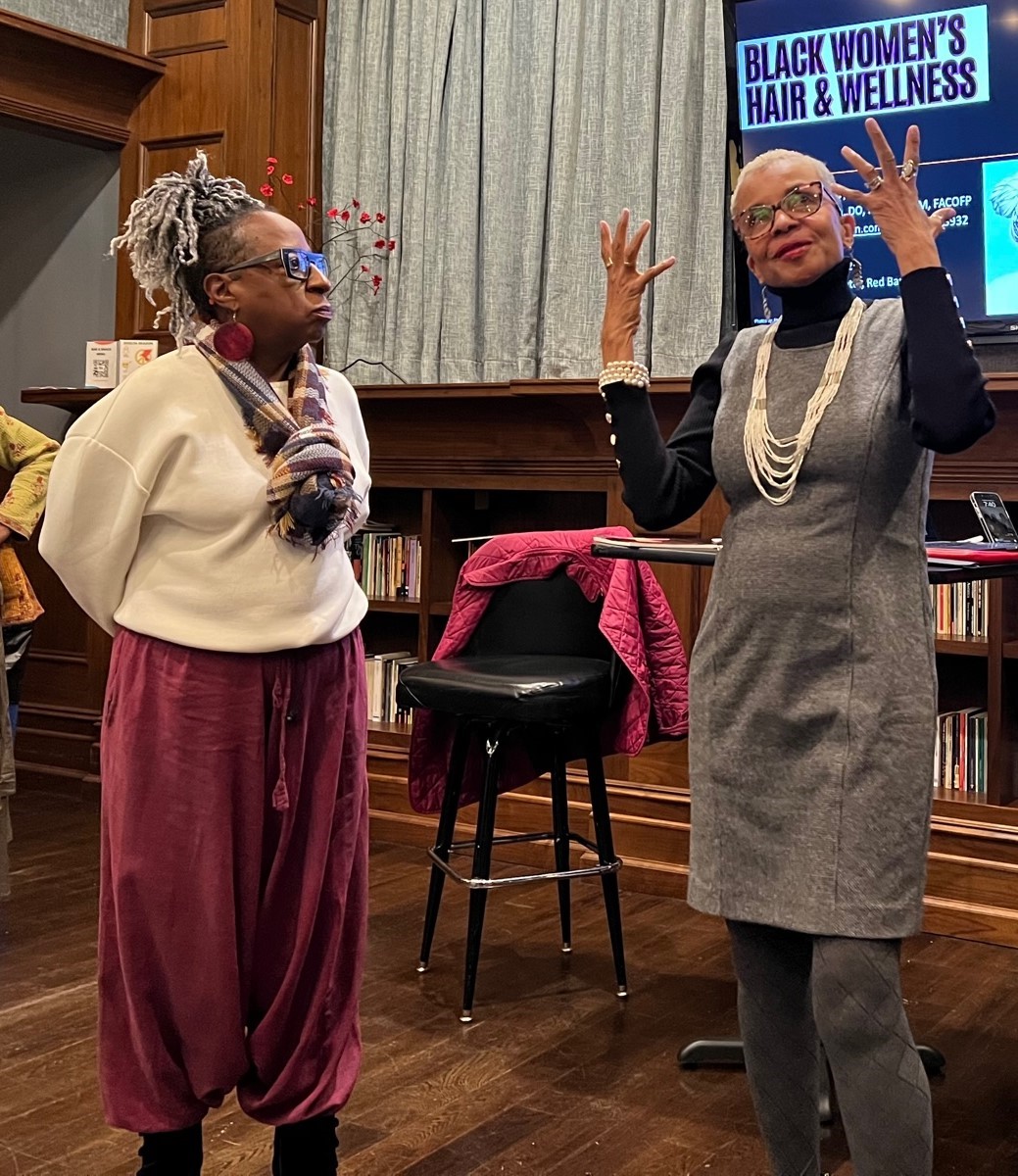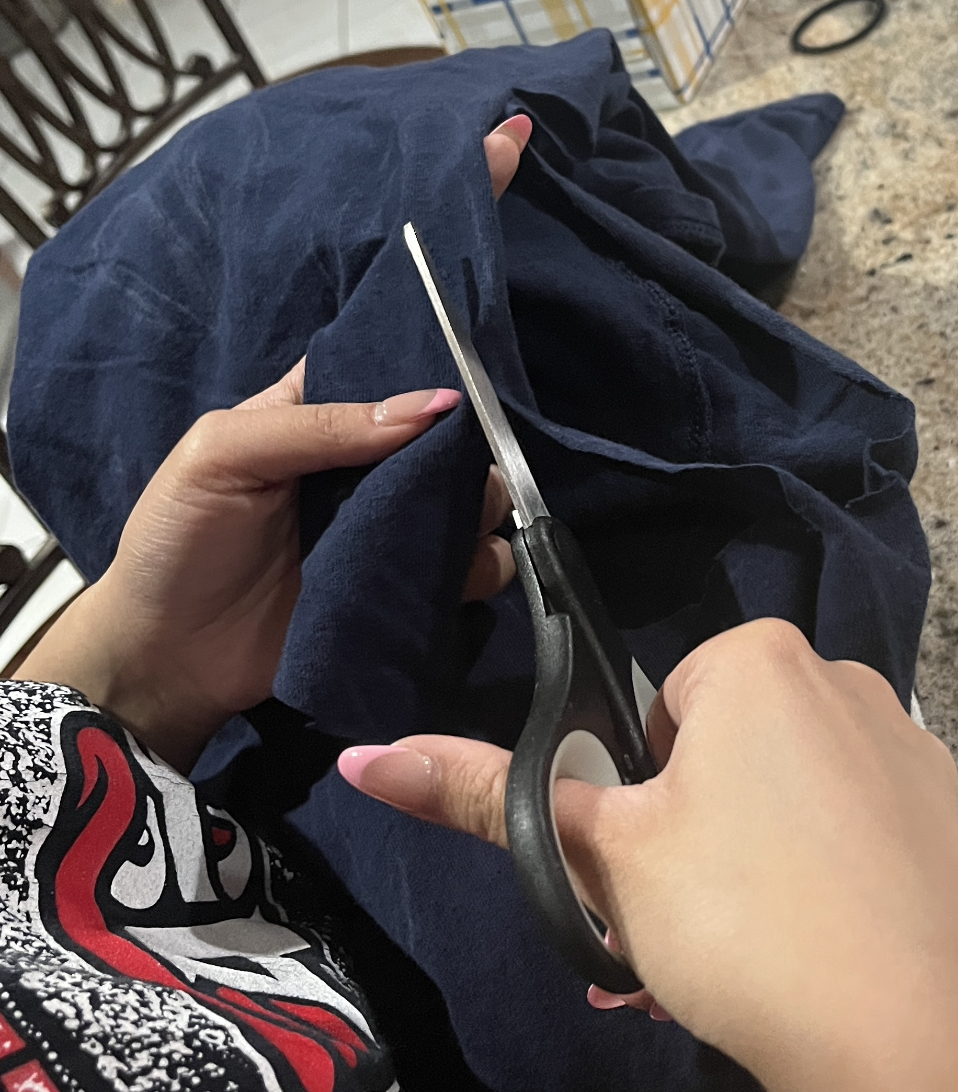On Oct. 19, Brookdale students and members of the public enjoyed an interactive presentation of “Black Women’s Hair & Wellness” at the Two River Theater in Red Bank led by Gilda Rogers, executive director of the T. Thomas Fortune Foundation & Cultural Center of Red Bank and an adjunct history professor at Brookdale, and Dr. Carol Penn, a board certified family medicine practioner.
The two women engaged in a thought-provoking discussion about Black women and their relationship to their hair with a historical backdrop of African pride. Although the focus was on women’s hair, the male members in the audience shared their evolution of coming to love the hair they were born with.
“Growing up I disliked my hair and was ashamed of it,” said Nathaniel Bostick, 43, a Brookdale student from Marlboro. “But now I realize that my hair is who I am; it’s something I will take with me for the rest of my life, and I am proud of it. It’s given me confidence and having my locks helps me hold my head up high.”
“Getting to the root” was the focus of the talk, which began with a discussion of the hair comb African women used in their elaborate hairstyles before they were enslaved and sent to the Caribbean and the American colonies. These hair combs – from plain to ornately decorated – denoted gender, royalty status, marital status and were worn to highlight the beauty of the African individual’s hair.
Traditionally, in Africa, taking care of the physical head was as important as the spiritual head, and some believed it to determine one’s destiny. Once Africans were enslaved, they were forced to shave and cut off their hair, essentially stripping them of their identity. It was also a way to control them. Rogers recommended the book “400 Years Without a Comb” by Willie L. Morrow for more details about this struggle.
Eventually, as more Africans were able to buy their freedom and settle in the area now known as Louisiana, the presence of both dark and light skinned free women who incorporated feathers and jewels into their elaborate hairstyles, was perceived as a “threat.” In 1786 the Tignon Laws were passed which “prohibited Creole women of color from displaying excessive attention to dress in the streets of New Orleans.” They were forced to wear a tignon (scarf) over their hair to show they belonged to the slave class, even if they were free women. Rogers said that the governor hoped that the laws would control women “who had become too light skinned or who dressed too elegantly, or who competed too freely with white women for status and thus threatened the social order.”
As the generations passed and the culture moved from African to African-American, Black women absorbed Americanism and the message that Black hair needed to be changed to meet the social construct of the established white European beauty model – light skin and straight hair.
Rogers explained: “Growing up, getting our hair done every two weeks was a ritualistic chore. Every black household used straightening combs and hot curlers, heated on the stove, despite the occasional burns to our neck and ears. It wasn’t enjoyable, but we believed it had to be done and so we did it. This is what Black culture represents when we talk about our hair.”
Following the Civil Rights Act and the Voting Rights Act, there was a rise of a Black youth culture that was determined to be themselves. They embraced their African roots, starting with their hair. Afros, ornate combs, Afro picks, colorful dashikis, all representing the Motherland, Africa, were embraced, once again.
Faith Ismail, 19, an English major from Eatontown, said she didn’t understand the phrase ‘Our hair is political. But now, listening to this talk, it’s clear to me. It’s been eye opening.”
Ismail also recalled her grandmother being furious with her when Ismail shaved the sides of her head for her current hairstyle. “This program is helping me get a better understanding of why shaving my hair was so offensive to her and why she reacted so strongly.”
White corporate America at the time was not ready for this cultural shift and would not hire individuals with Afro-cultured hair, so the Black community again relied on hair relaxers and other hair straighteners, often containing toxic ingredients and emittine dangerous fumes, Rogers said.
Finally, in 2019, the CROWN act (Create a Respectful and Open World for Natural Hair) was established and Race-based hair discrimination in the workplace or school is now illegal in 22 states.
Rogers explained how this changed. “The editor of Essence Magazine, Susan Taylor, was instrumental in helping us Black women learn to love ourselves and our authenticity. We have finally come to terms with our hair. We were trying to live up to a look that wasn’t what grew out of our heads. We have had a struggle trying to make peace with our hair for a very long time. It’s only within the last 20 years or so that we’ve embraced our hair – preferring to let it be natural.”
We are moving in a more positive direction in loving our hair, Rogers said. Recent statics show 71 percent of Black women now choose to wear their hair natural, and there is a 31 percent drop in the use of hair relaxers. As we start to educate ourselves then we can start to move in a more equitable direction with respect and appreciation for one another, she said.
Rogers then turned the program over to Dr. Carol Penn.
Penn discussed a variety of health issues that can impact one’s hair. She noted that some things that affect the hair are out of an individual’s control, such as cancer treatments. However, diet, exercise and stress reduction can help with other issues. Penn suggested not choosing hairstyles that are pulled up tightly, impacting scalp health and circulation.
Specific vitamins and dietary suggestions were shared, as well as recipes for conditioning one’s hair using herbs and natural substances. Emphasis was placed on stress reduction for overall health and wellness, and Penn led the group through the movements of a guided meditation and urged participants to continue the practice every day.
The audience asked questions and shared their hair stories, some heartbreaking – losing hair to cancer treatments – and joyful appreciation – thanking all of the Black women in the room for their strength and beauty.
Koran Hosan, a psychology major from Union, said, “I loved how Gilda Rogers and Dr. Penn went over the history of Black hair. I never knew any of that before – like how scarfs became a thing – and all of this was just so important to me – for everyone – to absorb and learn.”
Kenneth Grant, 19, a media studies major from Matawan, ended the event with these beautiful words:
“Our (Black) hair holds memories and stories. It holds the DNA of our ancestors. It’s spiritual and magical. I think using the word Crown is a great way to describe our hair. It’s a beautiful expression of the power of blackness, as it defies gravity. Nobody else’s hair can do what our hair does… My hair is a huge part of my identity; it’s become my calling card. I never feel better than when my hair is big and poofy.”
RECEIPE FOR HEALTHY HAIR AND SKIN
Courtesy of Dr. Carol Penn
The following recipe will stimulate and protect the scalp, hair follicles and skin.
Makes about 24 treatments
1 cup of apple cider vinegar
2-3 sprigs of fresh rosemary or 3 tablespoons of dried rosemary
2-3 sprigs of fresh lavender or 3 tablespoons of dried lavender
2-3 sprigs of fresh sage or 3 tablespoons of dried sage
Method:
1. In a wide mouth jar add the herbs and vinegar, shake it up, and soak it for about two weeks, away from light and heat. After two weeks, strain the liquid, throw away the herbs, and what remains is the tincture you’ve created.
2. Mix one tablespoon of the vinegar tincture to one cup of water,
3. Apply the tincture/water mixture after shampooing and allow it to sit in your hair for five, ten or 15 minutes before rinsing or using conditioner.
For a facial rinse follow the same proportions above – one tablespoon of tinctured vinegar to a cup of water and put the water/vinegar mixture in a little spritzer bottle and spray on the face. This helps to protect the first few layers of the skin and leave it dewy and beautiful.
The tincture will last for several months at room temperature. To extend the life of the tincture further, refrigerate.































